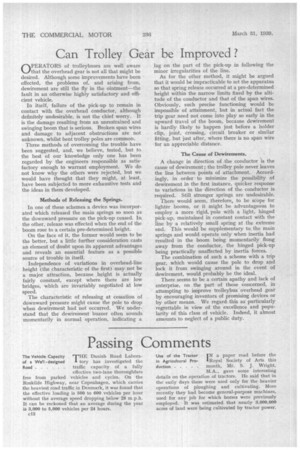Can Trolley Gear be Improved ?
Page 66

If you've noticed an error in this article please click here to report it so we can fix it.
OPERATORS of trolleybuses are well aware ‘...../that the overhead gear is not all that might be desired. Although some improvements have been effected, the problems of, and arising from, dewirement are still the fly in the ointment—the fault in an otherwise highly satisfactory and efficient vehicle.
In itself, failure of the pick-up to remain in contact with the overhead conductor, although definitely undesirable, is not the chief worry. It is the damage resulting from an unrestrained and swinging boom that is serious. Broken span wires and damage to adjacent obstructions are not unknown, whilst bent trolley poles are common.
Three methods of overcoming the trouble have been suggested, and, we believe, tested, but to the best of our knowledge only one has been regarded by the engineers responsible as satisfactory enough to warrant employment. We do not know why the others were rejected, but we would have thought that they might, at least, have been subjected to more exhaustive tests and the ideas in them developed.
Methods of Releasing the Springs.
In one of these schemes a device was incorporated which released the main springs so soon as the downward pressure on the pick-up ceased. In the other, release was effected when the end of the boom rose to a certain pre-determined height.
On the face of it, the former would seem to be the better, but a little further consideration casts an element of doubt upon its apparent advantages and reveals an essential feature as a possible source of trouble in itself.
Independence of variations in overhead-line height (the characteristic of the first) may not be a major attraction, because height is actually fairly constant, except where there are low bridges, which are invariably negotiated at low speed.
The characteristic of releasing at cessation of downward pressure might cause the pole to drop when dewirement had not occurred. We understand that the dewirement buzzer often sounds momentarily in normal operation, indicating a lag on the part of the pick-up in following the minor irregularities of the line.
As for the other method, it might be argued that it would be impracticable to set the apparatus so that spring release occurred at a pre-determined height within the narrow limits fixed by the altitude of the conductor and that of the span wires. Obviously, such precise functioning would be impossible of attainment, but in actual fact the trip gear need not come into play so early in the upward travel of the boom, because dewirement is hardly likely to happen just before a holder clip, joint, crossing, circuit breaker or similar fitting, but just after, where there is no span wire for an appreciable distance.
The Cause of Dewirements.
A change in direction of .the conductor is the cause of dewirement ; the trolley pole never leaves the line between points of attachment. Accordingly, in order to minimize the possibility of dewirement in the first instance, quicker response to variations in the direction of the conductor is required. Still stronger springs are undesirable.
There would seem, therefore, to be scope for lighter booms, or it might be advantageous to employ a more rigid., pole with a light, hinged pick-up, maintained in constant contact with the line by a relatively small spring at the extreme end. This would be supplementary to, the main springs and would operate only when inertia had resulted in the boom being momentarily flung away from the conductor, the hinged pick-up being practically unaffected by inertia forces.
The combination of such a scheme with a trip gear, which would cause the pole to drop and lock it from swinging around in the event of dewirement, would probably be the ideal.
There seems to be a certain apathy and lack of enterprise, on the part of those concerned, in attempting to improve trolleybus overhead gear by encouraging inventors of promising devices or by other means. We regard this as particularly regrettable in view of the excellence and popularity of this class of vehicle. Indeed, it almost amounts to neglect of a public duty.
























































































































































